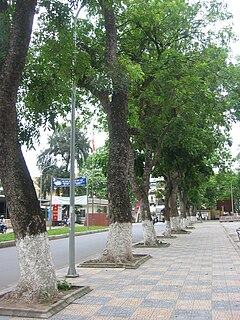
Meliaceae, the mahogany family, is a flowering plant family of mostly trees and shrubs in the order Sapindales.

The International Union for Conservation of Nature (IUCN) Red List of Threatened Species, founded in 1964, is the world's most comprehensive inventory of the global conservation status of biological species. It uses a set of precise criteria to evaluate the extinction risk of thousands of species and subspecies. These criteria are relevant to all species and all regions of the world. With its strong scientific base, the IUCN Red List is recognized as the most authoritative guide to the status of biological diversity. A series of Regional Red Lists are produced by countries or organizations, which assess the risk of extinction to species within a political management unit.

The conservation status of a group of organisms indicates whether the group still exists and how likely the group is to become extinct in the near future. Many factors are taken into account when assessing conservation status: not simply the number of individuals remaining, but the overall increase or decrease in the population over time, breeding success rates, and known threats. Various systems of conservation status exist and are in use at international, multi-country, national and local levels as well as for consumer use.

Shorea is a genus of about 196 species of mainly rainforest trees in the family Dipterocarpaceae. The genus is named after Sir John Shore, the governor-general of the British East India Company, 1793–1798. The timber of trees of the genus is sold under the common names lauan, luan, lawaan, meranti, seraya, balau, bangkirai, and Philippine mahogany.

Entandrophragma cylindricum is a tree of the genus Entandrophragma of the family Meliaceae. It is commonly known as sapele or sapelli or sapele mahogany, as well as aboudikro, assi, and muyovu.

Cariniana pyriformis is a species of woody plant in the family Lecythidaceae. It is found in Brazil, Colombia, Costa Rica, and Venezuela. It is threatened by habitat loss.
Bersama swynnertonii is a species of plant in the Francoaceae family. It is endemic to Zimbabwe. It is threatened by habitat loss.

Helicia is a genus of 110 species of trees and shrubs, constituting part of the plant family Proteaceae. They grow naturally in rainforests throughout tropical South and Southeast Asia, including India, Sri Lanka, Indochina, Peninsular Malaysia to New Guinea and as far south as New South Wales.

Khaya anthotheca, with the common name East African mahogany, is a large tree species in the Meliaceae family, native to tropical Africa.
Khaya grandifoliola, also called African mahogany, Benin mahogany, large-leaved mahogany, or Senegal mahogany, is a species of plant in the family Meliaceae. It is found in Benin, the Democratic Republic of the Congo, Ivory Coast, Ghana, Guinea, Nigeria, Sudan, Togo, and Uganda. It is threatened by habitat loss.

Khaya ivorensis, also called African mahogany or Lagos mahogany, is a tall forest tree with a buttressed trunk in the family Meliaceae. It is found in Angola, Cameroon, Côte d'Ivoire, Gabon, Ghana, Liberia, and Nigeria where it grows primarily in lowland tropical rainforests. It is threatened by habitat loss.

Khaya senegalensis is a species of tree in the Meliaceae family that is native to Africa. Common names include African mahogany, dry zone mahogany, Gambia mahogany, khaya wood, Senegal mahogany, cailcedrat, acajou, djalla, and bois rouge.

Lovoa trichilioides, also called African walnut, Congowood, dibetou or tigerwood, is a species of plant in the family Meliaceae. It is found in Angola, Cameroon, the Republic of the Congo, the Democratic Republic of the Congo, Ivory Coast, Gabon, Ghana, Liberia, Nigeria, Sierra Leone, Tanzania, and Uganda. It is threatened by habitat loss. Germination success is somewhat limited by short-lived seeds which are heavily predated. Exploitation rates are high. It is one of the two principal timber species in Congo.
Shorea almon is a species of plant in the family Dipterocarpaceae. It is native to Borneo and the Philippines.
Shorea palosapis is a flowering plant in the Dipterocarpaceae family. It is commonly called Philippine Mahogany or White Lauan. It is endemic to the Philippines. It is threatened by habitat loss which stems from recent human involvement in its natural habitat.

Swietenia humilis is a species of tree in the family Meliaceae. It is one of three species in the genus Swietenia, all three of which are regarded as "genuine mahogany." At 6 metres (20 ft), it is one-fifth the height of S. mahagoni and one-sixth the height of S. macrophylla. Its species name, humilis, means "small" or "dwarfish".
Tannodia swynnertonii is a species of plant in the family Euphorbiaceae. It is found in Mozambique, Tanzania, and Zimbabwe.

Tieghemella heckelii is a tree species of the genus Tieghemella in the plant family Sapotaceae. The species occurs in Cameroon, Ivory Coast, Gabon, Ghana, Liberia, Nigeria, and Sierra Leone and is threatened by habitat loss and over exploitation. This timber tree species can grow up to 45 meters tall and 1.2 meters in diameter. One individual, the Big Tree of Oda, is 66.5 m (218 ft) tall and 396 cm (13 ft) in diameter and is believed to be the tallest tree in West Africa.

Turraeanthus africanus is a species of plant in the family Meliaceae, also known by the common names avodiré, apeya, engan, agbe, lusamba, wansenwa, African satinwood, and African white mahogany.

Arctostaphylos pringlei is a plant that grows at elevations between 4000 and 7000 ft in southern California, Arizona, and southwest Utah.















